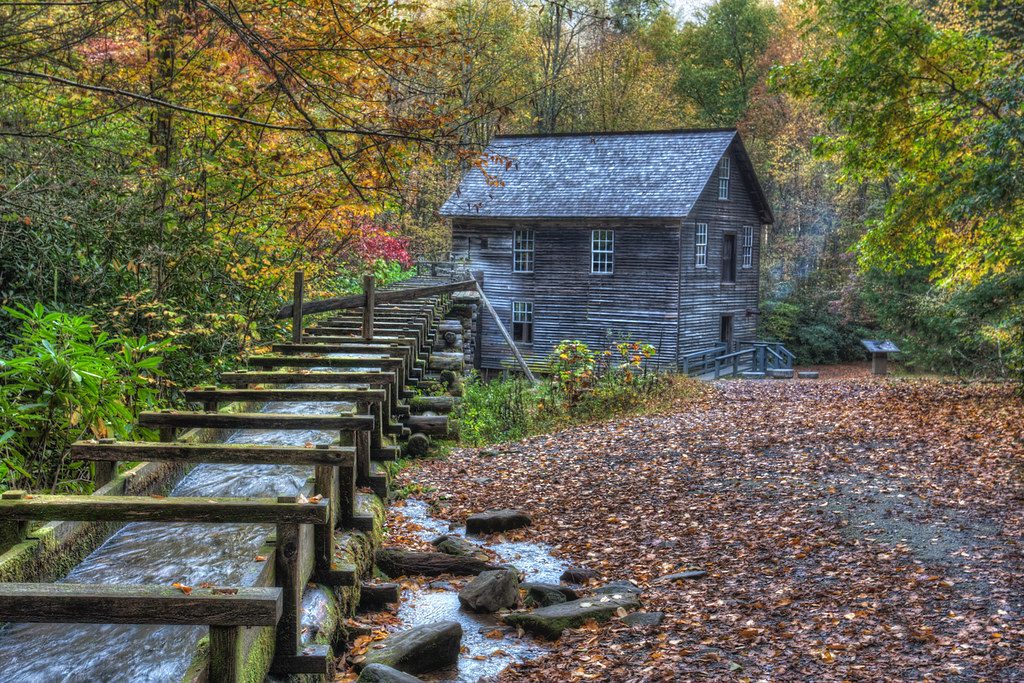Adjacent to the Oconaluftee Village in Cherokee N.C., you can step back in time to learn the history of the Eastern Band of the Cherokee Indians, and the early settlers of the Smoky Mountains. Places like the Mountain Farm Museum and Mingus Mill offer a glimpse into early Appalachian life. Early Scotch-Irish, German, and English immigrants settled the area in the mid-1700s, bringing their cultures and influences to the heavily forested, rocky slopes of the NC Great Smoky Mountains.
Learn the History of Early Appalachian Life at Mountain Farm Museum
To experience first-hand what life was like for these immigrants, you need to go no farther than the Mountain Farm Museum just off the Oconaluftee River Trail at the entrance to the Great Smoky Mountains National Park. First, stop by the state-of-the-art Oconaluftee Visitor Center for a free map and the opportunity to ask park rangers questions and hear their insights into the displays. Wander through the exhibits and media presentations, and maybe pick up a souvenir at the gift shop and bookstore. Then step outdoors and through a hundred-plus-year time warp.
Around the 1950s, the numerous buildings at this open-air museum were moved from their original locations within the Great Smoky Mountains National Park to their current location, where they can be preserved properly and seen collectively as a living display of the day-to-day activities of early farm life. Explore the authentic barn, smokehouse, spring house, apple house, and working blacksmith shop, all original structures dating back to the 1800s and 1900s. And don’t miss the historical farming and agriculture also happening on site.
Perhaps most fascinating about the museum are the log houses where actual settlers once lived. Pay special attention to the single hardwood log house, The David House, made from local Chestnut trees before a blight that later decimated their population.
Admission to the Mountain Farm Museum is free.
Insider Tip: In the early morning and early evening hours, free-range elk oftentimes can be spotted grazing in the fields next to the Visitor Center. Witness the rebirth of a population that was brought back from the brink of extinction through the successful efforts of local conservationists.
Visit Mingus Mill
A short half-mile north of the Mountain Farm Museum and Oconaluftee Village is Mingus Mill, a historic, water-powered turbine used for grinding corn. Built in 1886, the mill was key to the survival of the immigrants who relied on the resulting cornmeal, especially in the difficult winters. Today, visitors can purchase cornmeal and other mill-related products on site.
It would be remiss to not acknowledge to impact the Cherokee People had on the survival and eventual thriving of the early settlers to these mountains. It is widely recorded that the Scots, especially, and Cherokee had an amiable relationship due to many common aspects of their cultures, including societies organized around kinship and clan instead of land ownership. They both also identified as being fiercely independent people who had been subjected to ruling aggressors. In fact, many of the Scots took Cherokee wives and lived together as one in communities. In large part, it was only through the early intervention and mentorship of the Cherokee People that early immigrants survived the harsh landscape they call home today.
Exploring Trails Near Sacred Waters
There are several other exciting, one-of-a-kind experiences to explore while in the area. The Oconaluftee River Trail, which begins at the Visitor Center, takes you on an easy, 1 ½-mile stroll (each way) to the outskirts of Cherokee, NC. The walking path can even accommodate a baby stroller. Pets and bicycles are also welcome, which is uncommon in this area. The nearby Mingus Creek Trail is a far more challenging adventure along a 5.8-mile-long route with a high degree of difficulty. But you will be well rewarded with stunning views, pristine creeks and fields of wildflowers.
Anglers from around the world also flock to these waters for some extreme Fly Fishing. The Oconaluftee River, considered to be “sacred waters” by the Cherokee and known as the “Luftee,” is a beautiful, freestone river that drops 2,000 feet over 10 miles. It flows through downtown Cherokee and Qualla Boundary, the homeland of the Eastern Band of Cherokee Indians, and is most famous for its abundant healthy Rainbow, Brook and Brown Trout. In fact, it holds the North Carolina Record for a Brown Trout weighing in at 15.9 pounds!
When you add some cornmeal from Mingus Mill to your catch of the day (unless, of course, you are catching and releasing,) you will be eating exactly like the hearty immigrants who traveled across the world to start a new life in the Great Smoky Mountains of NC.
For more unique vacation activities while you’re here, visit must-do activities in and around Cherokee, NC.
* * *
Featured image: “Mingus Mill” by Photomatt28 is licensed under CC BY-NC-ND 2.0.

